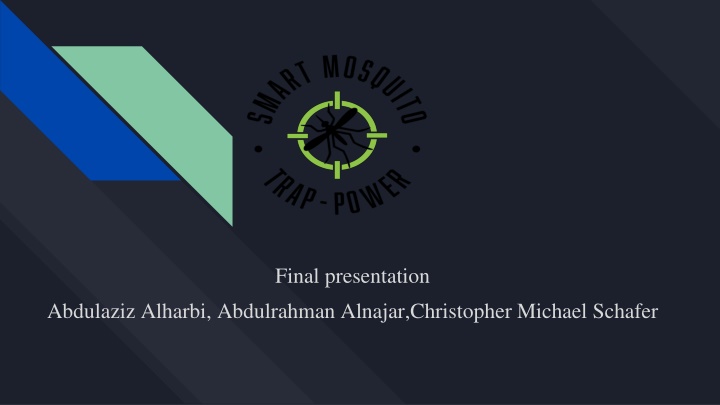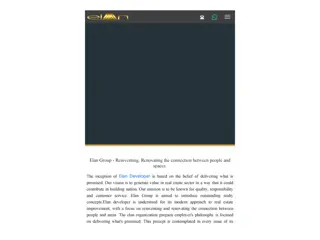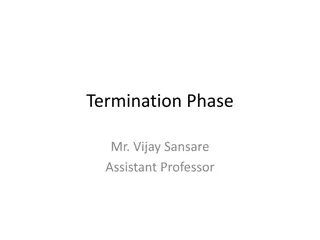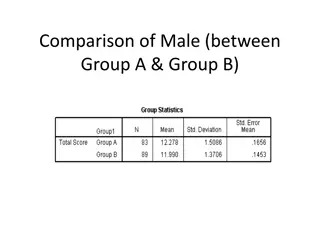
Smart Mosquito Trap Development for Research Purposes
Explore the journey of developing a smart mosquito trap for research in remote areas. Dr. Hepp's requirements for a long-lasting, weatherproof, and travel-friendly trap led to the creation of prototypes and subsystems. The project focuses on solar panels, battery banks, and durability testing to meet the power needs of capturing mosquito populations efficiently.
Download Presentation

Please find below an Image/Link to download the presentation.
The content on the website is provided AS IS for your information and personal use only. It may not be sold, licensed, or shared on other websites without obtaining consent from the author. If you encounter any issues during the download, it is possible that the publisher has removed the file from their server.
You are allowed to download the files provided on this website for personal or commercial use, subject to the condition that they are used lawfully. All files are the property of their respective owners.
The content on the website is provided AS IS for your information and personal use only. It may not be sold, licensed, or shared on other websites without obtaining consent from the author.
E N D
Presentation Transcript
Final presentation Abdulaziz Alharbi, Abdulrahman Alnajar,Christopher Michael Schafer
Project Introduction/Motivation Dr. Hepp- Evolutionary Biologist at Northern Arizona University Works with a research team to study and understand different types of mosquitoes all over the world Studies diseases of mosquitoes including West Nile Virus and St. Louis encephalitis virus (SLEV), mainly in Arizona and surrounding areas Dr. hepp needs a mosquito trap in remote areas to capture these mosquito populations The trap uses a small fan and a detection circuit to capture and study these mosquitoes, so the trap needs a power source to constantly power the trap Abdulaziz Alharbi
Project Approach Dr Crystal Hepp needs a smart mosquito trap that meets these requirements: Long lasting (seven day requirement) --We wanted to meet this requirement with a mixture of solar panels and a large capacity battery Weatherproof --Need a weatherproof battery and protected solar panels Partially solar powered power source --Need an array of solar panels that are efficient yet small enough to carry Travelable -- Dr. Hepp will need to take this to remote areas and on planes, so it must be small enough to put in luggage and follow common FDA guidelines Abdulrahman Alnajar
Prototype 1 Abdulaziz Alharbi
Prototype 2 Abdulrahman Alnajar
Prototype 3 Christopher Schafer
WBS Fully operational Smart Mosquito Trap Battery Bank (60) Solar Panel (30) DC/AC Converter (10) Current and Voltage Ratings (20) Voltage output requirement (70) Size (10) Durability (20) Durability (10) Power Testing (30) Weather (20) Size Issues (20) Christopher Schafer
Subsystem 1: Solar Panel The solar panel should have the capability to power the battery to ensure it never dies Must be weatherproof. calculate the power that goes into the battery. testing the solar panel when it is sunny or cloudy. relates to our overview because our power system is required to have a solar panel to ensure battery doesn t die Abdulaziz Alharbi
Subsystem 2: 12 volt battery The battery should be long lasting. Other team are working on detection, we must know how much power the microcontroller will draw so we can adjust accordingly. how much power will the solar panel charge the battery in each day (sunny, cloudy, and rainy). Without the solar panel the battery will not be able to long last for seven days, because the solar panel will charge the battery for the whole week. also, without the battery, the whole tap is impossible to power Abdulrahman Alnajar
Subsystem 3: DC/AC converter The DC/AC converter is critical to project completion. the panel generates DC power, so a converter is necessary to run an AC machine. without this converter, the battery is useless, the solar panel will continue to charge a battery that never discharges, and the project will be impossible to complete. Christopher Schafer
Abdulaziz Alharbi and responsibilities Timeline Solar Tracker: Old solar system was inefficient and rather unreliable We ve proposed a newer, more efficient system using combination of old solar system and solar cells rated at 5v, 0.6w . Using two 10rpm, 6v geared electric motors. This allows the motor to constantly move the panels, maximizing power output. This will allow maximum life of battery. Solar cell is weatherproof Testing of panels has shown that battery can last throughout the night.
Abdulrahman Alnajar Timeline and responsibilities Battery The max allowed is 160 watt hours per TSA regulations. Originally, we invested in a 12V, 7Ah lead acid battery This was tested for a long time, but realized TSA (Transportation Security Administration) tend to be strict about lead acid batteries. Furthermore, the Lead-Acid batteries are rather heavy, and become a hassle to travel with. After consulting with Dr. Hepp, we concluded a 12v, 12Ah Lithium Ion battery would be the perfect balance between travel ability and durability We received our new battery We didn t meet with the detection team. Ran many tests to ensure battery is durable and large enough to support the load for extended periods of time.
Christopher Schafer Timeline and Responsibilities DC/AC Converter the panel generates DC power, so a converter is necessary to run an AC machine. without this converter, the battery is useless, the solar panel will continue to charge a battery that never discharges, and the project will be impossible to completed. Converter has been tested and implemented, no further action is required
Challenges Testing was rigorous Broken solar charger had to be replaced Finding the balance between durability and longevity Finding loads similar to that of the trap and microcontroller Christopher Schafer
Final Product Final product includes 1 solar panels, a 12 volt lithium ion battery, and a dc/ac converter to plug the trap into. Product is travellabe, durable, long lasting, and inexpensive Abdulaziz Alharbi
Future Endeavors Solar Tracker to improve efficiency . Nice Package for easy carrying. Maximum power point tracking device to increase efficiency of solar panel. Low power mode during off peak mosquito hours Christopher Schafer
Conclusion The goal of this project was to design and implement an off grid power system for Dr. Hepps mosquito trap Trap had to be lightweight, travellable, durable, and long lasting We met all of the requirements of the project and we met those requirements through hard work and rigorous testing of the trap over the course of the year Unfortunately, due to current situations we could not optimize everything or work with the detection team as much as we desired Abdulrahman






















